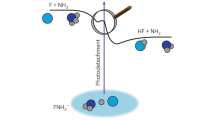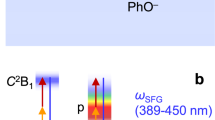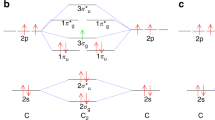Abstract
The reaction of low-energy electrons with neutral molecules to form anions plays an important role in chemistry, being involved in, for example, various biological and astrochemical processes. However, key aspects of electron–molecule interactions, such as the effect of incremental solvation on the initially excited electronic resonances, remain poorly understood. Here two-dimensional photoelectron spectroscopy of anionic anthracene and nitrogen-substituted derivatives—solvated by up to five water molecules—reveals that for an incoming electron, resonances red-shift with increasing hydration; but for the anion, the excitation energies of the resonances remain essentially the same. These complementary points of view show that the observed onset of enhanced anion formation for a specific cluster size is mediated by a bound excited state of the anion. Our findings suggest that polycyclic aromatic hydrocarbons may be more efficient at electron capture than previously predicted with important consequences for the ionization fraction in dense molecular clouds.

This is a preview of subscription content, access via your institution
Access options
Access Nature and 54 other Nature Portfolio journals
Get Nature+, our best-value online-access subscription
$29.99 / 30 days
cancel any time
Subscribe to this journal
Receive 12 print issues and online access
$259.00 per year
only $21.58 per issue
Buy this article
- Purchase on Springer Link
- Instant access to full article PDF
Prices may be subject to local taxes which are calculated during checkout




Similar content being viewed by others
Data availability
The raw photoelectron images that are used to construct Fig. 1, together with their photoelectron spectra, are available at https://doi.org/10.5281/zenodo.4314369. All other results are derived from these data. Source data are provided with this paper.
Code availability
Photoelectron images have been analysed using polar onion peeling, which is available at https://www.github.com/adinatan/PolarOnionPeeling (Matlab version) or http://www.verlet.net/research.html (Labview version).
References
Alizadeh, E. & Sanche, L. Precursors of solvated electrons in radiobiological physics and chemistry. Chem. Rev. 112, 5578–5602 (2012).
Boudaı̈ffa, B., Cloutier, P., Hunting, D., Huels, M. A. & Sanche, L. Resonant formation of DNA strand breaks by low-energy (3 to 20 eV) electrons. Science 287, 1658–1660 (2000).
Ingólfsson, O. Low-energy Electrons: Fundamentals and Applications (CRC Press, 2019).
Fabrikant, I. I., Caprasecca, S., Gallup, G. A. & Gorfinkiel, J. D. Electron attachment to molecules in a cluster environment. J. Chem. Phys. 136, 184301 (2012).
Smyth, M., Kohanoff, J. & Fabrikant, I. I. Electron-induced hydrogen loss in uracil in a water cluster environment. J. Chem. Phys. 140, 184313 (2014).
Kočišek, J., Pysanenko, A., Fárník, M. & Fedor, J. Microhydration prevents fragmentation of uracil and thymine by low-energy electrons. J. Phys. Chem. Lett. 7, 3401–3405 (2016).
Sieradzka, A. & Gorfinkiel, J. D. Theoretical study of resonance formation in microhydrated molecules. I. Pyridine–(H2O)n, n = 1,2,3,5. J. Chem. Phys. 147, 034302 (2017).
McAllister, M. et al. Solvation effects on dissociative electron attachment to thymine. J. Phys. Chem. B 123, 1537–1544 (2019).
Lengyel, J. et al. Electron-triggered chemistry in HNO3/H2O complexes. Phys. Chem. Chem. Phys. 19, 11753–11758 (2017).
Poštulka, J., Slavíček, P., Fedor, J., Fárník, M. & Kočišek, J. Energy transfer in microhydrated uracil, 5-fluorouracil, and 5-bromouracil. J. Phys. Chem. B 121, 8965–8974 (2017).
Meißner, R. et al. Low-energy electrons transform the nimorazole molecule into a radiosensitiser. Nat. Commun. 10, 2388 (2019).
Schulz, G. J. Resonances in electron impact on diatomic molecules. Rev. Mod. Phys. 45, 423–486 (1973).
Christophorou, L. G. Electron–Molecule Interactions and their Applications (Academic Press, 1984).
Horke, D. A., Li, Q., Blancafort, L. & Verlet, J. R. R. Ultrafast above-threshold dynamics of the radical anion of a prototypical quinone electron-acceptor. Nat. Chem. 5, 711–717 (2013).
Jordan, K. D. & Burrow, P. D. Temporary anion states of polyatomic hydrocarbons. Chem. Rev. 87, 557–588 (1987).
Regeta, K. & Allan, M. Autodetachment dynamics of acrylonitrile anion revealed by two-dimensional electron impact spectra. Phys. Rev. Lett. 110, 203201 (2013).
Anstöter, C. S., Bull, J. N. & Verlet, J. R. R. Ultrafast dynamics of temporary anions probed through the prism of photodetachment. Int. Rev. Phys. Chem. 35, 509–538 (2016).
Anstöter, C. S. et al. Mode-specific vibrational autodetachment following excitation of electronic resonances by electrons and photons. Phys. Rev. Lett. 124, 203401 (2020).
Tielens, A. G. G. M. Interstellar polycyclic aromatic hydrocarbon molecules. Annu. Rev. Astron. Astrophys. 46, 289–337 (2008).
Tielens, A. G. G. M. The molecular universe. Rev. Mod. Phys. 85, 1021–1081 (2013).
Omont, A. Physics and chemistry of interstellar polycyclic aromatic molecules. Astron. Astrophys. 164, 159–178 (1986).
Lepp, S. & Dalgarno, A. Polycyclic aromatic hydrocarbons in interstellar chemistry. Astrophys. J. 324, 553–556 (1988).
Allamandola, L. J., Tielens, A. G. G. M. & Barker, J. R. Interstellar polycyclic aromatic hydrocarbons—the infrared emission bands, the excitation/emission mechanism, and the astrophysical implications. Astrophys. J. Suppl. Ser. 71, 733–775 (1989).
Wakelam, V. & Herbst, E. Polycyclic aromatic hydrocarbons in dense cloud chemistry. Astrophys. J. 680, 371–383 (2008).
Draine, B. T. Physics of the Interstellar and Intergalactic Medium (Princeton University Press, 2011).
Allamandola, L. J., Bernstein, M. P., Sandford, S. A. & Walker, R. L. Evolution of interstellar ices. Space Sci. Rev. 90, 219–232 (1999).
Geers, V. C. et al. Lack of PAH emission toward low-mass embedded young stellar objects. Astron. Astrophys. 495, 837–846 (2009).
Bergin, E. A. & Tafalla, M. Cold dark clouds: the initial conditions for star formation. Annu. Rev. Astron. Astrophys. 45, 339–396 (2007).
Boogert, A. C. A. et al. The c2d Spitzer spectroscopic survey of ices around low-mass young stellar objects. I. H2O and the 5–8 μm bands. Astrophys. J. 678, 985–1004 (2008).
Garcia-Sanz, A., Carelli, F., Sebastianelli, F., Gianturco, F. A. & Garcia, G. Dynamics of formation of anthracene anions in molecular clouds and protoplanetary atmospheres. New J. Phys. 15, 013018 (2013).
Mensa-Bonsu, G., Lietard, A., Tozer, D. J. & Verlet, J. R. R. Low energy electron impact resonances of anthracene probed by 2D photoelectron imaging of its radical anion. J. Chem. Phys. 152, 174303 (2020).
Burrow, P. D., Michejda, J. A. & Jordan, K. D. Electron transmission study of the temporary negative ion states of selected benzenoid and conjugated aromatic hydrocarbons. J. Chem. Phys. 86, 9–24 (1987).
Gallup, G. A. Stable negative ions and shape resonances in a series of organic molecules. J. Chem. Phys. 139, 104308 (2013).
Carelli, F., Gianturco, F. A., Satta, M. & Sebastianelli, F. Attaching electrons to a 3-ring acene: structures and dynamics of anions in gas-phase anthracene. Int. J. Mass Spectrom. 365–366, 377–383 (2014).
Kregel, S. J., Thurston, G. K. & Garand, E. Photoelectron spectroscopy of anthracene and fluoranthene radical anions. J. Chem. Phys. 148, 234306 (2018).
Schiedt, J. & Weinkauf, R. Photodetachment photoelectron spectroscopy of mass selected anions: anthracene and the anthracene–H2O cluster. Chem. Phys. Lett. 266, 201–205 (1997).
Campbell, E. E. B. & Levine, R. D. Delayed ionization and fragmentation en route to thermionic emission: statistics and dynamics. Annu. Rev. Phys. Chem. 51, 65–98 (2000).
Andersen, J. U., Bonderup, E. & Hansen, K. Thermionic emission from clusters. J. Phys. B At. Mol. Opt. Phys. 35, R1 (2002).
Adams, C. L., Hansen, K. & Weber, J. M. Vibrational autodetachment from anionic nitroalkane chains: from molecular signatures to thermionic emission. J. Phys. Chem. A 123, 8562–8570 (2019).
Kokubo, S., Ando, N., Koyasu, K., Mitsui, M. & Nakajima, A. Negative ion photoelectron spectroscopy of acridine molecular anion and its monohydrate. J. Chem. Phys. 121, 11112–11117 (2004).
Castro, K. P. et al. Incremental tuning up of fluorous phenazine acceptors. Chem. Eur. J. 22, 3930–3936 (2016).
Bakker, H. J., Rezus, Y. L. A. & Timmer, R. L. A. Molecular reorientation of liquid water studied with femtosecond midinfrared spectroscopy. J. Phys. Chem. A 112, 11523–11534 (2008).
Maldoni, M. M., Egan, M. P., Robinson, G., Smith, R. G. & Wright, C. M. The phase of H2O ice and the librational band in OH231.8+4.2: new interpretations. Mon. Not. R. Astron. Soc. 349, 665–677 (2004).
Bull, J. N., West, C. W. & Verlet, J. R. R. On the formation of anions: frequency-, angle-, and time-resolved photoelectron imaging of the menadione radical anion. Chem. Sci. 6, 1578–1589 (2015).
Nielbock, M. et al. The earliest phases of star formation (EPoS) observed with Herschel: the dust temperature and density distributions of B68. Astron. Astrophys. 547, A11 (2012).
Rosu-Finsen, A., Lasne, J., Cassidy, A., McCoustra, M. R. S. & Field, D. Enabling star formation via spontaneous molecular dipole orientation in icy solids. Astrophys. J. 832, 1 (2016).
Bates, D. R. & Herbst, E. in Rate Coefficients in Astrochemistry (eds Millar, T. J. & Williams, D. A.) 41–48 (Springer, 1988).
Rogers, J. P., Anstöter, C. S., Bull, J. N., Curchod, B. F. E. & Verlet, J. R. R. Photoelectron spectroscopy of the hexafluorobenzene cluster anions: (C6F6)n− (n = 1–5) and I−(C6F6). J. Phys. Chem. A 123, 1602 (2019).
Eppink, A. T. J. B. & Parker, D. H. Velocity map imaging of ions and electrons using electrostatic lenses: application in photoelectron and photofragment ion imaging of molecular oxygen. Rev. Sci. Instrum. 68, 3477–3484 (1997).
Roberts, G. M., Nixon, J. L., Lecointre, J., Wrede, E. & Verlet, J. R. R. Toward real-time charged-particle image reconstruction using polar onion-peeling. Rev. Sci. Instrum. 80, 053104 (2009).
Acknowledgements
We thank M. McCoustra for useful discussions. This work has been funded by the EPSRC (EP/R023085/1 and EP/M507854/1).
Author information
Authors and Affiliations
Contributions
J.R.R.V. conceived the project. A.L. and G.M.-B. performed the experiments. A.L. analysed the data. All discussed the results and J.R.R.V. and A.L. wrote the paper.
Corresponding author
Ethics declarations
Competing interests
The authors declare no competing interests.
Additional information
Peer review information Nature Chemistry thanks Thomas Field, Xue-Bin Wang and the other, anonymous, reviewer(s) for their contribution to the peer review of this work.
Publisher’s note Springer Nature remains neutral with regard to jurisdictional claims in published maps and institutional affiliations.
Source data
Source Data Fig. 1
2D photoelectron spectra of PA(N)H water cluster anions.
Source Data Fig. 2
Energies of electronic states of PA(N)H water cluster anions.
Source Data Fig. 3
Photoelectron spectra of C14H10– and C14H10–(H2O)3.
Rights and permissions
About this article
Cite this article
Lietard, A., Mensa-Bonsu, G. & Verlet, J.R.R. The effect of solvation on electron capture revealed using anion two-dimensional photoelectron spectroscopy. Nat. Chem. 13, 737–742 (2021). https://doi.org/10.1038/s41557-021-00687-1
Received:
Accepted:
Published:
Issue Date:
DOI: https://doi.org/10.1038/s41557-021-00687-1
This article is cited by
-
Stabilized resonances are no less exciting
Nature Chemistry (2021)



